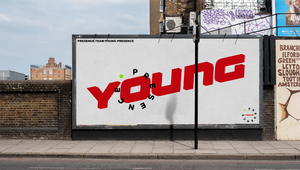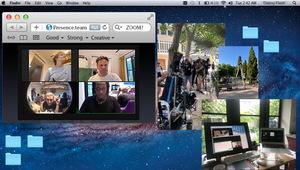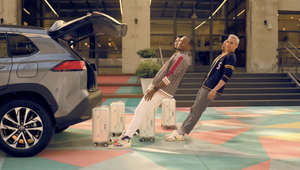
How Richard Swarbrick and Presence Moved Mountains for Netflix’s 14 Peaks

If you’re a fan of sport, there’s a fair chance you’ll be familiar with Richard Swarbrick’s work. But, even if you’re not, you’ll instantly understand why his imaginative, hand-painted style has proven so adept at capturing the epic euphoria of athletic endeavour.
The artist and filmmaker has built a career animating breathtaking moments in sport, creating an almost nostalgic effect on-screen which has proven popular with audiences across the world. His work includes beautiful campaigns for the FIFA World Cup, the NBA, and the Olympics amongst others.
During the initial lockdowns of the pandemic, however, Richard was presented with an altogether new kind of challenge. Netflix’s awe-inspiring mountaineering documentary, 14 Peaks, had entered production and required an artistic flair to be applied to scenes which couldn’t be captured on camera. Working together with the team at Presence, including producer Danny Fleet, Richard was able to produce animation which elevated the already-stupefying story of Nimsdai Purja - the man who set out to climb the world’s fourteen highest peaks in just seven months.
The film captured countless imaginations and dominated conversations upon its release last year, and continues to inspire new audiences today. To find out more about how animation helped bring Nimsdai’s story to life, LBB spoke with Richard.
Above: An example of Richard’s animation taken from Netflix’s 14 Peaks.
LBB> Your style is famed and favoured by sports stars. Did the opportunity for 14 Peaks come to you as a result of working a lot in the sports industry?
Richard> I recall Torquil [Jones, the director] and Nimsdai [Purja, its star] had seen some of my soccer and basketball work, but it’s still fair to say they took a leap of faith in approaching me with this project because it was so different to anything I’d done before. That being said, it’s hard to think of another sport quite so stunningly cinematic as mountaineering.
LBB> What was the brief like from Netflix, and how did you approach it?
Richard> The brief was very clear. They had an early work-in-progress edit of the film, and specific sections with gaps that required animation. These sequences covered parts of the story that would have been impossible to film: past memories, a HACE-induced hallucination, and a near-death experience.
As a comic book geek, the detail that particularly appealed to me was that I would get to design and illustrate a “Yeti”. I had to take some creative approaches to make the monster come to life, and I found that challenge enjoyable.
LBB> How closely did you work with Nimsdai to recreate these key moments in his life?
Richard> We didn’t work closely - in fact, we’ve actually never met in person. My involvement in the film all took place during the period of Covid lockdown and travel restrictions. Ideally, I would have filmed Nims acting out the scenarios as a basis for the illustrations but it wasn’t an option.
However, that limitation turned out to be the mother of inspiration in many ways, and I enjoyed the challenge of forcing myself to work in a different way.
LBB> How does working on documentaries compare to other animated projects you work on?
Richard> I love working on documentaries. I’ve only worked on a few (including one currently in production) and I enjoy the energy.
Invariably, the real work has been done because someone had the passion and motivation to document a story over a period of years. So you end up with a bunch of great footage that needs editing in such a way that is entertaining, yet integral to the truth. The job of the animator is to fill in the gaps and to tell the parts of the story that haven’t been captured on film.
LBB> And so, as an animator, does that make your process different to other projects?
Actually, it does. This is a good question. The end result is (hopefully) consistent with what I loosely refer to as my ‘animation style’, but the process is different. My traditional technique is Rotoscope, which means every painted frame is recreated from video footage. The difference on 14 Peaks was that, due to the limitations of lockdown, the paintings had to be created from scratch rather than be traced from a live-action source. I wasn’t able to film Nims on an Afghan rooftop or falling down a mountain.
It was great to be given this challenge, because it’s fundamentally changed the way I work.
LBB> Given you’re starting from scratch with this style of animation, how can you ensure that it’s a success?
Richard> It’s a case of getting the details right. Character likeness, for example, is essential. If the brief is to illustrate someone driving a car you need to find out exactly the make, model, and year of the car. It may be you see the car elsewhere in the film, or it might just be that this detail is in some way integral to the story or the character.
LBB> What transferable skills does working on long form documentaries afford when it comes to short form and commercial work?
Richard> Almost all of it is transferable, because in a way they’re very similar. In terms of our workflow it’s similar to commercials because it’s a series of regular deliverables and approvals.
14 Peaks, however, was different in this regard. There was an approval process but in the main we were given a lot of trust, and were able to get our heads down and get on with it. Perhaps this was partly due to the fact we were all getting used to working from home and connecting remotely via Zoom.
LBB> Can you tell us a bit about your working style on this project? Is it true that all of these scenes are hand painted?
Richard> That’s correct, yes. The technique, or ‘animation style’ I use involves hand-painting over live footage. There are some scenes (like the one with the Yeti) where I had to get creative with the live footage, and add to what I was seeing. For example, an actor might act out the scene and then I would trace or hand-paint the footage and then draw fur or a scary face on those frames to make him look more like the Yeti.
LBB> Are they physically painted and scanned, or do you use any special technology or techniques to achieve the final look?
Richard> I work with both digital and analog mediums. Either way it’s a slow process where every frame is hand painted. There are filters I use to enhance colour and texture.
I used to work in a completely analog way using a combination of Goulash paint, charcoal, chalk, and a whole variety of pens and pencils. I try to match the look of my old analog style in my digital process.
My commercial projects now are created digitally using a Wacom stylus and tablet. The client feedback process is so fluid and deadline-driven these days, you have to work in a format that is editable.
LBB> Did you have any reference material for this project - be it old photos or film, or just verbal notes?
Richard> Yes, there was a lot of reference material for the mountain scenes from the documentary rushes. It was important to get things just right so there were numerous revisions, particularly to clothes and mountaineering gear.
LBB> Finally, what were the most challenging aspects of the project and how did you overcome them?
Richard> Perhaps the biggest challenge was to create animation that lived up to the stunning cinematography much of which was shot by Nims himself. There was a buzz of excitement from day one between myself and the team at Presence. I remember a conversation with Danny Fleet (producer at Presence), and we knew this movie was going to be a hit. We knew the power of Nim’s personality and that the incredible story was going to captivate audiences.
As I’ve mentioned, Covid lockdown was a big challenge. With hindsight, I enjoyed the way we as an industry embraced Zoom during that period. Toddlers running around in the background was all part of the fun. Now we’re all on Zoom more than ever and I find it to be a productive way to work.

Above: Richard Swarbrick, drawn in his own unique style.













